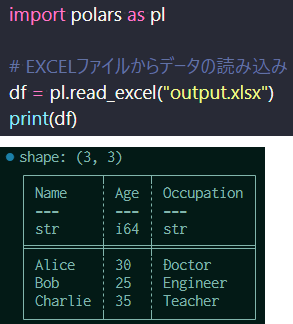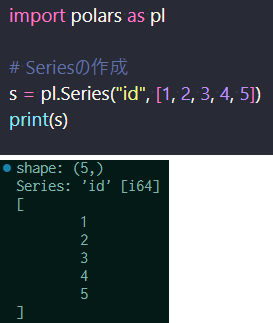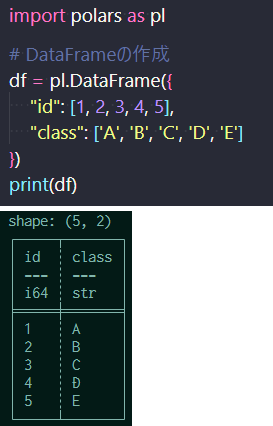初心者のためのDjango入門
■第20話:Rust製で高速!Polarsによるデータ集計と分析
(最終更新日:2023.06.26)

(絵が小さい場合はスマホを横に)
「Pandasデータを可視化しよう!」
Polarsは、PythonとRustで書かれた高速なDataFrameライブラリだ。
Pandasと同様に、データの操作と分析を容易にするための多くの機能を提供しており、機能としては類似している。
ただし、Pandasとは異なり内部の処理をRustで行うことにより、大量のデータを扱う際のパフォーマンスの向上やメモリ効率の改善に重点を置いている。
今回は、そんなPythonライブラリ、Polarsについて紹介する。
1.Polarsのインストール
仮想環境の設定やPython自体のインストールに関しては16話で説明した内容を見てほしい。
Pythonが使える環境で、「pip install polars」を行う。これだけで、Polarsを使うことができる。簡単である。
1点注意としては、excelやcsvファイルの読み込み、書き出しにはpandasとは別のライブラリが必要になる。
「pip install xlsx2csv」とコマンドを打って、インストールしよう。これで、Pandasとほぼ同様に、excelやcsvファイルの読み書きができるはずだ。

excelデータの読み込み(上)とその出力結果(下)
2.Polarsの基本的なデータ構造
Polarsは、データを操作するための2つの主要なデータ構造、SeriesとDataFrameを提供する。 これは、Pandasと全く一緒である。 念のため再度説明すると、Seriesは1次元の配列で、同じデータ型のデータを保持する。 一方、DataFrameは2次元のテーブルで、異なるデータ型のデータを保持することができる。 以下に、SeriesとDataFrameの作成例を示す。 Seriesを作成すると、その形状である(5, 1)(1は省略される)が表示され、1~5が格納されている様子が出される。

seriesの作成(上)とその出力結果(下)
DataFrameを出力すると、その形状である(5, 2)が表示され、1~5とA~Eが格納されている様子が出される。 また、それぞれの項目(idとclass)の型がi64(64bit整数型)、str(文字列型)という表記で示される。

データフレームの作成(上)とその出力結果(下)
3.Pandasとの比較
■パフォーマンスとメモリ効率
Polarsは、大量のデータを扱う際のパフォーマンスの向上とメモリ効率の改善に重点を置いている。
これは、PolarsがRustで書かれているため、メモリ管理と並列処理がより効率的に行われる。
一方、PandasはPythonで書かれており、大量のデータを扱う際にはパフォーマンスやメモリ効率の問題が生じることがある。
■並列処理
Polarsはマルチスレッドの操作をサポートしており、大量のデータを高速に処理することが可能だ。
一方、Pandasは主に単一スレッドで動作し、大量のデータの処理には時間がかかることがある。
■APIの違い
PolarsとPandasのAPIは似ていますが、完全に同じではない。一部の操作は、両者の間で異なる関数やパラメータを使用することがある。
したがって、PandasからPolarsに移行する際には、APIの違いに注意する必要があります。
例えば、データフレームの列を選択する方法は、PandasとPolarsで少し異なります。
Pandasは「df_pandas["A"]」とするのに対して、Polarsは「df_polars.select("A")」と書く。
このように、メソッドの呼び出し方が異なるので、
分からなくなったら公式サイトで使い方を確認しよう。
■データ型のサポート
Pandasは、Pythonの基本的なデータ型に加えて、カテゴリ型や日付/時間型などの特殊なデータ型をサポートしている。
一方、Polarsはこれらの特殊なデータ型をサポートしていますが、その実装はPandasとは異なる場合がある。
■エコシステムとコミュニティ
Pandasは、Pythonのデータ分析エコシステムの中心的な部分を占めており、
多くのライブラリ(例えば、Matplotlib、Seaborn、Scikit-learnなど)との統合が深い。
また、Pandasは広範なコミュニティサポートと豊富なドキュメンテーションを持っている。
一方、Polarsは比較的新しいライブラリで、そのエコシステムとコミュニティはまだ発展途上だ。
しかし、そのパフォーマンスと効率性は、大規模なデータセットを扱う必要があるデータサイエンティストやエンジニアにとって魅力的である。
4.まとめ
Polarsは大量のデータを効率的に処理したり、データ変換するのが得意である。
ただし、Pandasとは若干命令や必要なライブラリが異なるというところが注意点だ。
加えて、新しいライブラリであるが故、
Matplotlib、Seaborn、Scikit-learnなどの有名なライブラリとの連携に関しても今は注意が必要である。
これらの点を踏まえた上で、ハイパフォーマンスなPythonライブラリ、Polarsをぜひ活用してみよう。
▼参考図書、サイト
Rust製高速データフレームライブラリ、Polarsを試す Python Monthly Topics
pandasから移行する人向け polars使用ガイド qiita